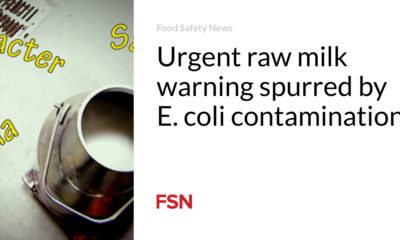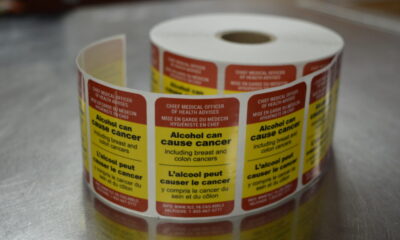Health
Alcohol warning labels face industry opposition, efficacy questions

If you twirl a bottle of alcohol and squint, you might see a text box with a warning. Usually in black and white, with letters two to three millimeters high, it reads:
GOVERNMENT WARNING: (1) According to the Surgeon General, women should not drink alcoholic beverages during pregnancy because of the risk of birth defects. (2) Consumption of alcoholic beverages impairs your ability to drive a car or operate machinery, and may cause health problems.
The label is a sort of rare link between generations. Today’s drinkers — the newest cohort of them born during the “Crazy In Love” summer of 2003 — receive the same warning as those who came of age in late 1989 (when Billy Joel’s “We Didn’t Start the Fire” topped the charts).
Over the past 35 years, the science of alcohol and its potential health harms has evolved, and some alcohol researchers and consumer protection advocates tell STAT that bottle labels should reflect that. Other nations, such as Ireland, are moving ahead with cancer warning labels on alcoholic beverages, but there’s no concrete sign such a move would happen in the U.S. Still, advocates see a glimmer of hope: For the first time in decades, the agency regulating most alcoholic drinks is set to release updated rules about what basic product information must be disclosed.
In meetings this spring, the Alcohol and Tobacco Tax and Trade Bureau signaled it could require beverage companies to share the ingredients, alcohol content, nutritional information, and any major food allergens present in their products. Unlike other foods and drinks Americans consume, most alcohol products are regulated by the TTB and don’t need to include basic information, such as calories.
For now, the government warning is not part of that discussion, but proponents of an updated label hope new rules from the TTB could pave the way for language that reflects potential health risks in the general population. It is one piece of many bubbling to the surface — and spurring debate — as federal officials decide what to tell Americans about alcohol in next year’s Dietary Guidelines for Americans.
Still, it’s not known how good labels are at changing alcohol consumers’ behavior long-term. Among the three key policies the World Health Organization recommends for reducing alcohol-related harms, labeling is backed by the thinnest evidence. Scientists are actively working to expand what we know. But even if labels and warnings were proven to make a dent in the number of deaths, injuries and disease attributable to alcohol, TTB doesn’t have an explicit public health charge, experts told STAT. Its main function is as a tax collection agency.
“They think that should come from the political leadership,” said Thomas Gremillion, director of food policy at the Consumer Federation of America.
Meanwhile, policies known to reduce alcohol-related harms, like higher taxes and reduced availability, go largely unused in the U.S.
Is trying to require a stronger alcohol label a waste of time?
The Yukon label experiment
Perhaps the best evidence for alcohol warning labels comes from Canada’s sparsely populated Yukon territory, on the border of Alaska. It was there that researchers conducted one of the few real-world studies of alcohol labels.
“It was just pure, dumb luck,” says Tim Stockwell, study co-author, of how the team was able to slap 300,000 labels on containers of alcohol sold at the government-run liquor store in the capital city of Whitehorse. The Yukon Liquor Corporation, which controls the flow of alcohol in the territory, agreed to let the researchers do the study. Unlike what sticks to U.S. bottles, the labels Stockwell and his colleagues designed were front and center, colorful, simply worded, focus group-tested, and had rotating messages to keep consumers’ attention.
The label that got the most attention ran for just shy of a month, on 46,000 alcohol containers sold in Whitehorse in late 2017. “Alcohol can cause cancer,” it warned. A wave of media coverage followed, spreading the word of the labels much further than the caribou forests of Yukon, said Stockwell, director of the Canadian Institute for Substance Use Research.
Then, the alcohol industry descended. “They made complaints, they were besieging the federal health minister’s office trying to get calls and meetings to stop this,” Stockwell said. The Yukon government, with insufficient resources to take on a multibillion-dollar industry like alcohol, paused the study. When it resumed after a few months, the cancer label was gone.
Researchers found total retail sales of alcohol per person decreased by 6% during the experiment. Sales of labeled products went down by 6.6%, while sales of unlabeled products in neighboring areas of the Yukon and Northwest territories went up by 7%. Even after the bottles went back to the old warning about pregnancy-related risks, sales decreased by about 10% from the pre-study baseline. It’s impossible to know how much of the effect was driven by strong media attention and increased awareness by word-of-mouth.
No other research has definitely proven that alcohol warning labels change behavior in the long term, though some data suggest people who drink the most are also most likely to receive the message. ”It’s almost like a mini billboard,” said Marissa Hall, who studies health warning labels at the University of North Carolina Gillings School of Global Public Health.
Label advocates often point to warnings on cigarettes as a success story, pointing to a steep decline in smoking rates after 1966, when the health warnings were added. But that change was accompanied by mass social and cultural change, legal action, and a crackdown on tobacco marketing tactics, among other things — all moves that haven’t happened with alcohol.
Even getting basic facts on alcoholic drinks has been a protracted battle.
‘People might be surprised what’s in there’
In 1988, Congress passed the Alcoholic Beverage Labeling Act and the all-caps government warning was born. The same law dictated that TTB should, with the Surgeon General, report back to lawmakers if there was a significant change in the science of alcohol-associated health harms that would necessitate a different warning label. The agency hasn’t done so. “We know a hell of a lot more about alcohol than we did in 1990,” said David Jernigan, a professor of health law, policy and management at Boston University School of Public Health. Jernigan has been a vocal critic of the alcohol industry for years, a perspective shaped by his research into the industry’s advertising and promotion strategies.
Advocacy groups have tried to nudge TTB. In the early 2000s, dozens of organizations led by the Center for Science in the Public Interest and the Consumer Federation of America filed a petition to compel TTB to act. They wanted the agency to require basic information, like calories and ingredients, including potential allergens, on the alcoholic beverages it regulates. TTB didn’t respond.
In late 2022 — almost two decades after the petition — the groups sued to try to force the agency’s hand. After several more delays, the TTB said it would release the labeling regulations this year. The agency did not respond to STAT’s request for a more concrete timeline.
For its part, the alcohol industry mostly doesn’t want mandatory labels. Many groups wrote to the TTB to express their concern. The Distilled Spirits Council of the United States (DISCUS), which represents some of the biggest names in spirits, said its members made a voluntary commitment to provide that information on products, either in the form of a label, URL or scannable QR code. That was set to begin in June.
“Spirits suppliers provide a significant amount of information about their products both to consumers and their regulators. Much of this information is required by law and much of it is provided on a voluntary basis in response to consumer demand for information about different products,” Amanda Berger, senior vice president of science and research for DISCUS, said in a statement.
DISCUS wants to provide consumers with “meaningful information” about alcoholic beverages, Berger said. “But it is also important to ensure that regulations are developed in a thoughtful manner so that they do not unduly burden distillers, do not overwhelm agency staff, or inadvertently confuse consumers.” Many raw materials used to make spirits may be broken down in the distillation process, rendering a full ingredients list less useful, she said.
Some in the beer industry made a similar promise to DISCUS’ years ago, and the TTB has had a voluntary labeling program for over a decade. Follow-through was pretty dismal, according to an analysis by CSPI. “It’s clear that voluntary initiatives aren’t sufficient,” said Eva Greenthal, a senior policy scientist at CSPI who’s been pushing for the nutrition facts (and conducted the voluntary labeling analysis).
The issue with URLs and scannable codes is that it creates an additional barrier between consumers and information, some experts say. And marketing can be woven into what should be straightforward facts. Take for example the ingredients list of a European gin, which is sold stateside but adheres to an E.U. pledge to provide information voluntarily. The ingredients list and alcohol content by volume are printed on the back of the container. But above those, and more prominent, is a scarlet-red QR code that takes consumers to the company’s website.
Music, sound effects and motion graphics introduce the ingredients as vivid illustrations—bubbling tubes of alcohol, a pair of floating fruits, a twirling ribbon of spring water, and a gently swaying herb bush. “Certainly one of the most aromatic and excellent varieties in the world,” reads one caption about a botanical. It takes over a minute to get through the list.
While there isn’t a lot of evidence that clear nutrition labeling changes buyers’ choice of alcohol, there are data from other product labels, like food. Where governments have forced the food industry to add front-of-package nutrition warnings for products with high sodium, saturated fats, calories or added sugars, people purchased fewer of those foods. That, in turn, persuaded food companies to cut back on salts, fats, and sugars, Greenthal said. The same could happen with alcoholic drinks, which are a black box right now (with the exception of FDA-regulated fermented sugar drinks, like hard teas and seltzers, which must carry Nutrition Facts panels).
In the case of mixed cocktails, a growing sector, “people might be surprised what’s in there,” said Greenthal, who hasn’t tested the alcoholic products herself. Looking at FDA-regulated drinks offers researchers a window in. A 12-ounce can of a popular mixed vodka cocktail is 12.5% alcohol and contains over 300 calories and 25 grams of sugar. Just one of these cocktails would meet a woman’s maximum recommended daily sugar intake, and contain double the amount of alcohol federal dietary guidelines suggest is safe for her to drink in a day.
Such information would equip consumers to make more informed choices, Greenthal said.
Nutrition labels could also soften the ground for alcohol-control efforts like tougher health warnings, increased taxes, or limited hours of sale, some advocates say, citing studies that suggest greater awareness about products like alcohol can lead to more public support for regulation.
“People will be more supportive of the tax policies and whatnot if they’re more aware of the health risk,” Gremillion said. “It’s hard to garner the political support to go up against the alcohol industry….they’re a tough opponent.”
TTB could decide to update the existing warning label, which contains no mention of how alcohol is a driver of a half-dozen cancers, including breast cancer.
Several people STAT spoke to said an endorsement from the surgeon general could make a big difference. Consider the hubbub in June when Surgeon General Vivek Murthy called for a warning label on social media. The links between alcohol and cancer are even more clear-cut, some argue, and less known. Consistently less than a third of the U.S. public is aware that alcohol can increase their cancer risk.
The surgeon general’s office did not respond to requests for comment.
DISCUS said it defers to the government’s authority to determine warning statements.
What new warning label might look like
A potent warning label would look almost nothing like what’s on bottles now, researchers say. Including images, icons and eye-catching colors on the front of the container would make it most effective, according to the scientific literature. (Elements like that are clearly visible on the heavily litigated tobacco warning labels released by the FDA.) Rotating labels with different messages can keep the warnings from “wearing out,” researchers say. “Effects are strongest right after the warning is implemented and they’re weaker two or five years later,” said Anna Grummon, a Stanford University behavioral scientist.
Opponents of a tougher warning have speculated that too aggressive a message could backfire if consumers think their rights are being infringed upon in some way. But some reactance — a mix of annoyance, surprise and defensiveness one might feel when confronted with a warning label — can be good, said Hall, who ran an online study of various alcohol warning labels.
To her and other researchers STAT spoke to, spending years fine-tuning a label is well worth it. Yes, scientists still need to gather more data on whether warnings change behavior. Regulatory bodies would need to get on board, too. Still, small details — label design, word choice, imagery — multiplied across the population and over many years, can have a big effect, Grummon said. If advocates do get a chance to update health warnings on alcohol containers, she said, they need to have data-supported plans.
“We want to be ready with evidence about the best possible policy when that window of opportunity hopefully arises,” Grummon said.
STAT’s coverage of chronic health issues is supported by a grant from Bloomberg Philanthropies. Our financial supporters are not involved in any decisions about our journalism.













